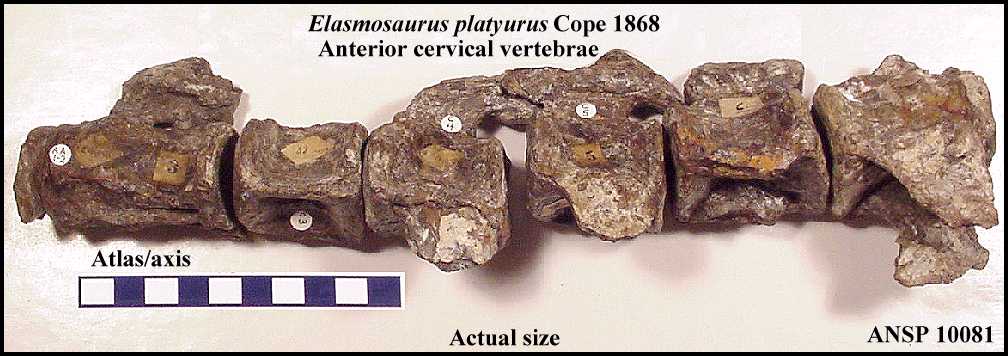

The tale of a tail:
Or how easy it was to put the head on the wrong end of Elasmosaurus platyurus Cope 1868
Copyright ę 2002-2013 by Mike EverhartMore about Elasmosaurus and the recovery of possible missing pieces here
We will probably never know what went through the mind of young (28 year old) Professor Edward D. Cope (1840-1897) when he opened the shipping crates he had just received from the wilds of western Kansas in March of 1868. Cope had begun a career in herpetology at the Smithsonian Institution in 1861, and was already quite knowledgeable regarding modern lizards (Ken Carpenter, pers. comm. 2002, reminded me that most lizards have short necks and long tails). Cope had seen the remains of Jurassic plesiosaurs from Europe, including at least one specimen at the ANSP, and his mentor, Joseph Leidy, was the expert on American plesiosaurs (Click here for Leidy's papers on Cimoliasaurus and Discosaurus). This specimen, however, was the largest and most complete plesiosaur found in North America up to that time, and was also the first major Cretaceous vertebrate of any kind to be reported from Kansas. In that regard, it was very important to Cope. (See ePapers: Plesiosaur publications up to and including the discovery of E. platyurus)
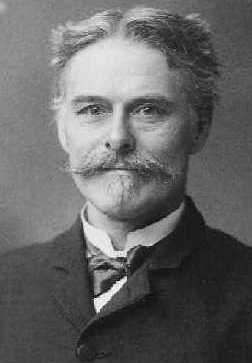 |
Certainly what Cope saw that day must have dramatically shaped his
vision of what this strange creature looked like because he described and named it
(unofficially) in a quick note for publication in LeConte's railroad survey report,
which is dated February (?) of 1868, but was probably published no sooner than March,
1868. Cope initially believed that there were two specimens of plesiosaurs included
in the shipment from western Kansas, based on the extreme differences in the sizes of the
articulated vertebrae: "... The collection recently received from Dr. Turner, contains remains of two species of Marine Saurians, the larger of some forty feet in length, the other not more than half as large. Both are allied to the Plesiosaurus, the smaller being provisionally referred to the immediate American representative of that genus. The larger approaches genera already known from cretaceous rocks of New Jersey and southern States, called by Leidy Discosaurus and Brimosaurus. A much larger portion of the Kansas Reptile than of these, has however, been discovered, and sufficient to indicate its distinction from them, and that it was one of the largest and most formidable of the group of Saurians to which it belongs. General peculiarities of structure may be indicated as follows: it possesses a tail of great length, which was elevated, compressed and adapted for sculling the ponderous body through the water. ... This dragon was named from the singular plates which project from the under surface of many of the vertebrae, Elasmosaurus platyurus Cope." |
| The remains of Elasmosaurus platyurus had been
discovered early in 1867 by Dr. Theophilus H. Turner (1841-1869), the U.S.
Army surgeon assigned to Fort
Wallace in western Kansas (see Map HERE). At the time, Fort Wallace was one of
the last military outposts between Kansas City and Denver, sitting along the route of the Butterfield Overland Dispatch
(a stagecoach line), about 25 miles east of the border between Kansas and Colorado (see
bottom of page for more historical links). It was also near the proposed route of the Kansas Pacific Railroad
which was then being constructed across Kansas (and still being surveyed at the time (see
LeConte, 1869). The soldiers at Fort Wallace provided some measure of protection in far
western Kansas for the settlers, travelers and railroad workers during the Indian
wars. Later, the U.S. Army would also escort paleontologists O. C. Marsh
and E. D.
Cope during their trips in search of Kansas fossils. While serving at Fort Wallace, Dr. Turner was able to spend some of his free time hunting buffalo and antelope, and collecting mineral specimens in the vicinity. In the spring of 1867, he was exploring a shale outcrop some 12 miles northeast of the fort, near the North Fork of the Smoky Hill River, when when he found the "fossil bones of a large animal" eroding from the side of a ravine. Dr. Turner provided three vertebrae to Dr. John LeConte when his survey party passed through Fort Wallace in June of that year. In turn, LeConte delivered two(?) of the vertebrae to Professor Cope at the Academy of Natural Sciences upon his return to Philadelphia in November, 1867. Cope then contacted Dr. Turner by letter in mid-December to ask him to secure the rest of the specimen. (See Almy, 1987 for the correspondence between E. D. Cope and Dr. Turner) |
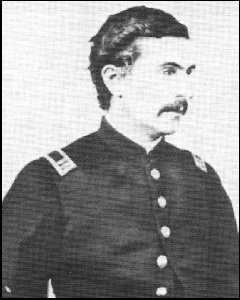 |
| The remains of Elasmosaurus were located by Turner at McAllaster Butte in the ‘middle’ or
‘organic-rich shale’ unit of the Sharon Springs Member (Zone of Baculites
asperformis, lower Middle Campanian) of the Pierre Shale, Logan County, Kansas (Gill,
Cobban, and Shultz, 1972). The middle unit is about 27 m (90 ft.) thick and extends upward
to within 3 m (10 ft.) of the contact with the Weskan Member. It is a hard, gray,
buttress-weathering shale and contains an abundance of vertebrate fossils. The upper
portion of the unit is also characterized by a layer of large septarian limestone
concretions that were found above the horizon of the Elasmosaurus remains.
Coincidentally, the type locality of Elasmosaurus is within a mile of the site
where seven vertebrae from a second elasmosaur specimen (FHSM VP-398) were discovered by a
local farmer and collected by George Sternberg in 1954.
This same specimen was re-discovered in 1991 by Pete Bussen, and produced two more
vertebrae and the largest gastroliths ever documented
(Everhart, 2000). A dig on this specimen in 1998
produced a large number of ribs and gastralia. Both of these localities may also be
stratigraphically contemporaneous with two other recent finds of elasmosaurs (Styxosaurus
snowii) associated with gastroliths in the same vicinity: (New
Jersey Plesiosaur Dig) (Cincinnati Dig - 1999). Although Cope assumed that the remains had come from the Niobrara Chalk (the Pierre Shale was not well known at the time), his 1868 description certainly of the matrix surrounding the specimen is accurate: "The beds were argillaceous, with much gypsum; the latter mineral coating the bones. The age was Cretaceous; perhaps, according to LeConte, the upper middle." |
| Once the specimen was delivered to Cope in early March, 1868, he must have worked on it night and day to prepare the remains. One of the first things he would have noted was a mostly articulated and quite long series of vertebrae (more than 70) that went from centra that were four inches across on one end down to about an inch across at the other (about the diameter of a wooden broomstick). Welles (1943, p. 136) noted that the "anterior cervicals are small. In fact they seem absurdly small for so large an animal." Most of the other vertebrae in the series were also quite small: (Early middle of series); (Late middle of series). Only at the base of the articulated series did the vertebrae become as large as the few (5-6) dorsal vertebrae that had been found. Cope assumed that the tail was the main organ of propulsion of this new kind of giant plesiosaur and even doubted that Elasmosaurus had hind limbs (no limb material was found with the remains). | |
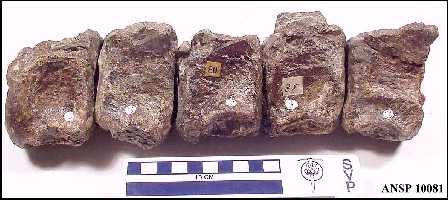 |
At the other end of the remains, there was another articulated series of vertebrae that Cope (1868) noted were quite unusual, because of the "the presence of chevron-like bones on the inferior surfaces of the cervical vertebrŠ" (chevron bones are more commonly associated with the caudal vertebrae in the tails of reptiles). Adding to Cope's belief that these were the neck vertebrae of the plesiosaur, Turner had found the muzzle of the plesiosaur's skull near by. Originally found crushed tightly together (and figured that way in Cope, 1869, 1870, Pl. II, Fig. 8, 8a, 8b), the muzzle was eventually separated by someone into upper and lower halves at sometime between 1952 and 1973 (Pers. comm, Ken Carpenter, 2002). |
| On March 24, 1868, Cope made a formal report to the Academy of Natural Sciences of Philadelphia; "Prof. Cope exhibited to the Academy several fragments of a large Enaliosaurian, discovered by the Academy's correspondent at Fort Wallace, Kansas, Dr. Theoph. H. Turner. Portions of two vertebrae, brought east by Dr. LeConte from his geological survey of the Pacific Railroad route, had previously indicated to the speaker the existence of an animal related to the Plesiosaurus, and the recovery of the greater part of the reptile had confirmed this affinity. The remains consisted of over one hundred vertebrŠ, with numerous portions of ribs, the greater part of the pelvic and scapular arches, with two long bones somewhat like femora. Part of a muzzle, with teeth, belonged to the same animal." | |
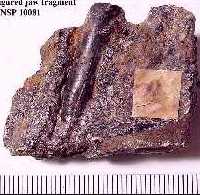 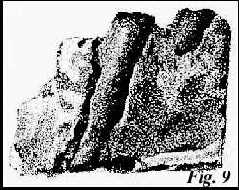 |
Although Cope noted and figured one jaw fragment (right) containing the base of two teeth, he apparently did not notice, or consider important, three other fragments of Elasmosaurus that also contained the roots of several teeth. In addition, there are several other bone fragments curated with the specimen that appear to be fragments of the skull, but are too damaged to identify. |
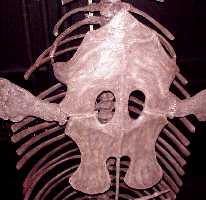 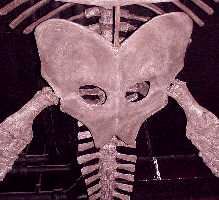 |
Cope also reported that the pectoral and pelvic
girdles had been discovered in association with the vertebrae. Although they can no longer
be located, Cope included figures of them in his 1869 and 1870 publications. These
pictures of the pectoral girdle (left) and the pelvic girdle (right) are from the model of
Elasmosaurus that is on display at the Academy of Natural Sciences. According to Cope (1869, 1870), there were no limb elements recovered with the specimen and the gastralia (belly ribs) were missing despite a second search by Turner. Cope also estimated that at least 10 of the dorsal vertebrae were missing. Unlike many specimens of elasmosaurs found since, there were no gastroliths found reported by Cope. (See below) |
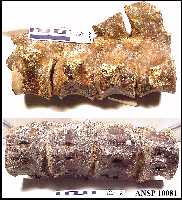 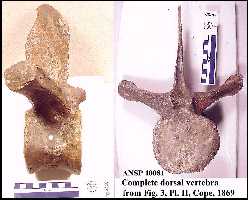 |
On July 14, 1868, Cope again reported to the Academy; "The structure of the vertebral column in Elasmosaurus was pointed out. It was stated to possess apparently no zygapophyses throughout its whole length, but in place of these, the zygosphen and zygantrum articulation. The articulations of the vertebrŠ were therefore the reverse in respect to direction of their surfaces from the usual form among vertebrata. In fact, the structure of the genus was shown to be entirely new and peculiar among vertebrated animals. The genus Cimoliasaurus Leidy, was stated to exhibit the same structure, and required that the vertebrae should be reversed in order to read their connections correctly." For a "life-size" view of Fig. 3, Plate II, GO HERE. Welles (1952) noted that "approximately 13 centra" were missing in the dorsal region. |
| In his first and subsequent publications, Cope
reported the remains of several fishes associated with the specimen: "The matrix
beneath the dorsal vertebrŠ contained remains of perhaps six species of fishes, several
ctenoid, among them a known Enchodus, and a SphyraŠa, to be called Sph.
carinata Cope." While Cope assumed these to be the last meal of the Elasmosaurus,
it is more likely that they were bits and pieces of small fish that died later near the
remains and were incorporated into the hard calcite matrix that covered the bones of the
elasmosaur. Left: Small teeth, bones and scales are still visible in the matrix curated with the type specimen. |
|
| In August, 1869, Cope personally published a 'pre-print' of his
work on the extinct reptiles of North America and included a drawing of his reconstruction
of Elasmosaurus (Plate II) as a centerpiece. He then sent copies of the
publication to his colleagues around the world: Cope, E. D., 1869. Synopsis of the Extinct Batrachia and Reptilia of North America, Part I. Trans. Amer. Phil. Soc. New Series, 14:1-235, 51 figs., 11 pls. |
|
| Cope (1869) would soon create an new order that he called "Streptosauria" [reversed lizards] to contain this strange new animal: "Under this name I have characterized a group of high rank among the Reptiles which is allied to the Sauropterygia. The diagnosis will be as follows. The articular processes of the vertebrŠ, reversed in their directions; viz., the anterior looking downwards, the posterior upwards ... The characters of this order are altogether peculiar. They are largely derived from an almost complete specimen of Elasmosaurus platyurus Cope in the Museum of the Academy of Natural Sciences of Philadelphia. The vertebral character may be explained on the supposition that the zygosphen and zygantral articulation is present, and the zygapophysial wanting, or that the obliquity of the faces of contact of the zygopophyses is reversed." | |
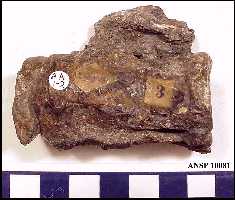 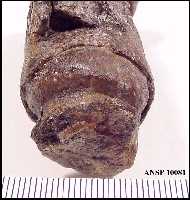 |
However, Cope had overlooked one very important detail. At one end of the long series of vertebrae that he had described as the tail of Elasmosaurus, was a small but unusual looking lump of bone. Since Cope believed this to be the tail of this new form of plesiosaur, he may have disregarded it and left it for later preparation. Once it was prepared, there could be no doubt that what it really was. Leidy (1870) would note that the end of the column terminated "in a co÷ssified axis and atlas, as is the case also in the mature Plesiosaurus. The cup of the atlas still retains the hemispherical occipital condyle." Left side view); (Top view); (Anterior view from above); (Closer anterior view from above); (Posterior view); (Anterior view); and (Right side view). |
| In plesiosaurs and other reptiles, the atlas and axis
vertebrae are often fused into a single bone that articulates with the occipital condyle
at the back of the skull. In the case of Elasmosaurus platyurus, the round
end of the occipital condyle had broken off the skull and was preserved within the
cup of the atlas vertebra.
|
|
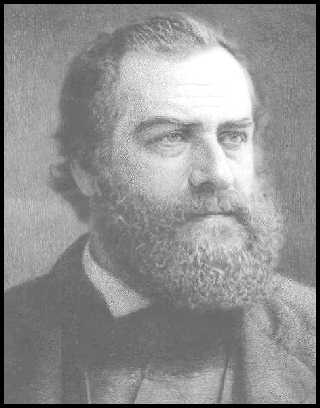 |
Left: Joseph
Leidy (1823-1891) - The Father of American vertebrate paleontology At the March 8, 1870 meeting of the Academy of Natural Sciences of Philadelphia, Joseph Leidy commented publicly on Cope's mistake of putting the head of Elasmosaurus on the tail of the skeleton. For some unknown reason, Leidy may have made his report on Cope's error to the Academy without first discussing it with Cope (?), setting off a brief dispute and exchange of published notes between the two noted paleontologists during 1870. |
| Cope reacted quickly, requesting that the preprints
he had sent out be returned at his expense, and incompletely rewriting his original
'backwards' description of Elasmosaurus. The revised version was published in the
late Spring of 1870. Unfortunately, Cope did not change the 1869 date on the cover of the
publication: Cope, E. D., 1870*. Synopsis of the extinct Batrachia and Reptilia of North America. Trans. Amer. Philos. Soc., (n. s.) 14:1-252 + i-viii, 55 figs., 14 pl. (*Revision of Cope, 1869, same title, with publication dated listed as August, 1869, published after March, 1870) |
|
| The missing partial vertebra? On page 48 of the
revised (1870) version of his "Synopsis...", Cope mentions that "Three and
one-half [cervical vertebrae] are thus found to be missing in this region." Neither
Williston (1906) or Welles (1952) mentioned a half vertebra being missing or present. Of
the two, Welles wrote up the most exhaustive description of Elasmosaurus platyurus,
noting (p. 94) that the vertebrae "bear two sets of numbers, one printed and one
inked..." and also corrected the order of the vertebrae. In a box of fragments, a "one-half" cervical vertebra was found. While some of the other vertebrae have as many as three or four numbers, this fragment has no markings. (2nd photo HERE) Does this mean that the neck of Elasmosaurus platyurus was even longer than previously described? Stay tuned..... |
|
| Neither Turner or Cope reported finding any gastroliths associated with the specimen. At some point prior to 1995, someone working with the specimen found a foreign object embedded in the neural canal of the caudal vertebra labeled #85, removed it and placed it in a small plastic box with an unsigned note. Spamer, et. al., 1995, page 148, reported that "There is a single piece of bone accompanied by a note reading, 'Found in neural canal of 85th caud.'" Upon examination, I determined that this was actually a small, polished stone and is most likely a gastrolith that somehow had wedged itself into one of the tail vertebrae prior to fossilization. The gastrolith measures 21 x 10 x 8 mm. I also found what appears to be another depression on vertebra #81 that may have held another small stone at one time. (Another photo HERE) |

Postscript: Although Dr. Turner visited the Academy in March, 1868, he apparently did not ever get to meet Cope personally, or to see Cope's vision of what Elasmosaurus looked like. Turner died suddenly of "acute gastritis" in July, 1869, at the age of 28, while serving at Fort Wallace. The 'finger-pointing" over the mistakes made by Cope in the reconstruction of Elasmosaurus went back and forth between Cope and Leidy for a brief period in 1870. After that, the issue was essentially dropped except for a remark made by Marsh in the American Naturalist in 1873:
Marsh (1873, p. ix), states, "…after investigating a very perfect specimen for months, he placed the head on the end of the tail [emphasis added by Marsh], and restored the animal in this position as the type of a new order, Streptosauria." Cope did not reply.
Contrary to the popular mythology that surrounds this specimen, Marsh's comments in the 1890 New York Herald articles probably have no basis in fact. The brief controversy over Elasmosaurus in 1870 had very little to do with the later Bone Wars between Cope and Marsh:
| Twenty years later, on January 19, 1890, with perfect 20/20
hindsight, Marsh was quoted as saying: "The skeleton itself was arranged in the Museum of the Philadelphia Academy of Sciences, according to this restoration, and when Professor Cope showed it to me and explained its peculiarities, I noticed that the articulations of the vertebrae were reversed and suggested to him gently that he had the whole thing wrong end foremost. His indignation was great, and he asserted in strong language that he had studied the animal for many months and ought to at least know one end from the other. It seems he did not, for Professor Leidy in his quiet way took the last vertebrae of the tail, as Cope had placed it, and found it to be the atlas and axis with the occipital condyle of the skull in position. This single observation of America's most distinguished anatomist, whom Cope has wronged grievously in name and fame, was a demonstration that could not be questioned, and when I informed Professor Cope of it his wounded vanity received a shock from which it has never recovered, and he has since been my bitter enemy. Professor Cope had actually placed the head on the end of the tail in all his restorations, but now his new order was not only extinct, but extinguished." ....................... To which Cope replied the following day.... "To the charge of turning a lizard without a head wrong end about I answer "peccavi" [Latin - I have sinned] to some extent. But I wonder at Marsh to repeat this ancient story, since it compels me to bring into prominence another scientist, my predecessor in the same field [Joseph Leidy, (1823-1891)], who had done exactly the same thing and worse. I was able to correct part of the error of this author, but did not reverse the animal as I should have done. In a very short time, my predecessor saw the error he and I had committed and corrected it in print without previously informing me." |
History /Geography Note: It would be more than 30 years before Turner’s slate hill would be called McAllaster Butte. In 1868, however, there was no recognized name for the landmark other than, perhaps, what the Indians called it. It would also be referred to as "two buttes" by Dr. George Sternberg, another Army Doctor who served with Sheridan's campaign against the Indians. Marsh and Cope both collected from along the North Fork of the Smoky Hill River which is immediately east of McAllaster Butte. One writer of the day, W. E. Webb, even likened it to an "old sunken volcano" in his book, Buffalo Land.
The real connection between Turner’s slate hill and the later nearby town named McAllaster, was the Kansas Pacific (now Union Pacific) Railroad. The railroad was constructed through western Kansas in 1868-69 and arrived at the site where Thof’s Dragon was found sometime in late 1868. A small town called Sheridan was built just to the east of the slate hill and served as the railhead for workers and building materials for a short time. When construction of the railroad moved westward, Sheridan disappeared. Later another town called Lisbon was built on the same spot, but it only survived for about 20 years.
McAllaster was settled about 1893, and is located two miles west of the earlier town sites and about a mile west of the slate hill. According to Pete Bussen (pers. comm., 2002), a long time resident of nearby Wallace, McAllaster quickly grew as a farming community to more than 40 homes, with a two story, brick school house and several hundred citizens. It was situated along the Union Pacific Railroad, with State Highway 40 as its main street. However, by the depression days of the 1930s, McAllaster was losing its population and eventually was reduced to its present state: one home and a grain elevator. The highway was moved further south, out of town, and the railroad no longer stopped. Regardless of what happens to the town, however, the McAllaster name will live on at McAllaster Butte, the discovery site of Thof’s Dragon.
Photo credits: The photos of the Kansas Pacific Railroad under construction and the soldiers standing in front of the building at Fort Wallace were published on pages 48 and 55 in "Fort Wallace" by Leo E. Oliva and are used with permission of the author. See other books by Leo Oliva here.
References (cited and / or recommended):
Almy, K. J. 1987. Thof’s dragon and the letters of Capt. Theophilus Turner, M.D., U.S. Army, Kansas History Magazine, 10(3):170-200.Carpenter, K. 1999. Revision of North American elasmosaurs from the Cretaceous of the western interior, Paludicola, 2(2):148-173.
Cope, E. D. 1868. Remarks on a new enaliosaurian, Elasmosaurus platyurus. Proc. Acad. Nat. Sci. Phil., 20:92-93. (for meeting of March 24, 1868)
Cope, E. D. 1868. (on new species of extinct reptiles). Proc. Acad. Nat. Sci. Phil., 20:181. (for meeting of July 14, 1868.
Cope, E. D. 1868. On a new large enaliosaur. Amer. Jour. Sci. ser. 2, 46(137):263-264. (September)Cope, E. D. 1869. [Remarks on extinct reptiles]. Proc. Acad. Nat. Sci. Phil. 20:313. (Meeting of Dec. 15, 1968; published February, 1869)
Cope, E. D. 1869. (A resolution thanking Dr. Theophilus Turner for his donation of the skeleton of Elasmosaurus platyurus). Proc. Acad. Nat. Sci. Phil., 20:314. (Meeting of December 15, 1868)
Cope, E. D. 1869. Synopsis of the extinct Batrachia and Reptilia of North America, Part I. Trans. Amer. Phil. Soc. New Series, 14:1-235, 51 figs., 11 pls. (pre-print dated August, 1869)
Cope, E. D. 1869. On the reptilian orders Pythonomorpha and Streptosauria. Proc. Boston Soc. Nat. Hist. XII 250-266.
Cope, E. D. 1870 (1869*). Synopsis of the extinct Batrachia and Reptilia of North America, Part I. Trans. Amer. Philos. Soc., (n.s.) 14:1-252 + i-viii, 55 figs., 14 pl. (*Revision of Cope, 1869, same title page, with publication dated listed as August, 1869, published after March, 1870)
Cope, E. D. 1870. On Elasmosaurus platyurus Cope. Amer. Jour. Sci., ser. 2, 50(148):140-141. (for July)
Cope, E. D. 1870. Additional note on Elasmosaurus. Amer. Jour. Sci., ser. 2, 50(149):268-269. (for September)
Cope, E. D. 1870. The fossil reptiles of New Jersey. The American Naturalist, 3:84-91. [includes another "head on the wrong end" recreation of Elasmosaurus, though this one is described in the text as Elasmosaurus orientalis]
Cope, E. D. 1870. Synopsis of the extinct Batrachia and Reptilia of North America, Part I. Trans. Amer. Philos. Soc., (n. s.) 14:1-252 + i-viii, 55 figs., 14 pl.
Cope, E. D. 1871. Synopsis of the extinct Batrachia and Reptilia of North America, Part I. Trans. Amer. Philos. Soc., (n. s.) 14:1-252 + i-viii, 55 figs., 14 pl. (final publication of volume 14, with four other articles)
Davidson, J. P. 2002. Bonehead mistakes: The background in scientific literature and illustrations from Edward Drinker Cope's first restoration of Elasmosaurus platyurus. Proc. Acad. Nat. Sci. Phil. 152:215-240.
Everhart, M. J. 2005. Elasmosaurid remains from the Pierre Shale (Upper Cretaceous) of western Kansas. Possible missing elements of the type specimen of Elasmosaurus platyurus Cope 1868? PalArch 4(3): 19-32.
LeConte, J. L. 1868. Notes on the geology of the survey for the extension of the Union Pacific Railway, E. D., from the Smoky Hill River, Kansas, to the Rio Grande. Review Printing House, Philadelphia, 76 p. with folded map.
Leidy, J. 1870. (Remarks on Elasmosaurus platyurus). Proc. Acad. Nat. Sci. Phil. 22:9-10. (for meeting of March 8, 1870). A brief summary of Leidy's March 8 remarks were printed in the July 21, 1870 issue of Nature 2:248.
Leidy, J. 1870. Discosaurus and its allies. Proc. Acad. Nat. Sci. Phil. 22:18-22. (April 5, 1870)
Leidy, J. 1870. On the Elasmosaurus platyurus of Cope. Amer. Jour. Sci. ser. 2, 49(147):392. (for May meeting)
Leidy, J. 1870. On Discosaurus and its allies. Amer. Jour. Sci., ser. 2, 50(148):139-140.
Marsh, O. C. 1873. Reply to Professor Cope’s explanation. Amer. Nat. 7(6):i-ix, Appendix. (May 20, 1873)
NoŔ, L.F. and Gˇmez–PÚrez, M. 2007. Postscript to Everhart, M.J. 2005. Elasmosaurid remains from the Pierre Shale (Upper Cretaceous) of western Kansas. Possible missing elements of the type specimen of Elasmosaurus platyurus Cope 1868? In PalArch’s Journal of Vertebrate Palaeontology 4, 3: 19–32. PalArch’s Journal of Vertebrate Palaeontology 2(1): 1-9
Oliva, L. E. 1998. Fort Wallace: Sentinel on the Smoky Hill Trail. Kansas State Historical Society, Topeka, KS, 133 pp.
Sachs, S., Kear, B.P., and Everhart, M.J. 2013. Revised vertebral count in the ôlongest-necked vertebrateö Elasmosaurus platyurus Cope 1868, and clarification of the cervical-dorsal transition in Plesiosauria. PLoS ONE 8(8): 6 pp. LINK
Spamer, E. E., E. Daeschler and L. G. Vostreys-Shapiro. 1995. A study of fossil vertebrate types in The Academy of Natural Sciences of Philadelphia; Taxonomic, systematic, and historical perspectives. Acad. Nat. Sci. Phil., Spec. Publ. 16, 434 pp.
Storrs, G. W. 1999. An examination of Plesiosauria (Diapsida: Sauropterygia) from the Niobrara Chalk (upper Cretaceous) of central North America, The University of Kansas Paleontological Contributions, (N. S.), No. 11, 15 pp.
Welles, S. P. 1943. Elasmosaurid plesiosaurs with a description of the new material from California and Colorado. University of California Memoirs 13:125-254. figs.1-37., pls.12-29.
Welles, S. P. 1952. A review of the North American Cretaceous elasmosaurs. Univ. Calif. Publ. Geol. Sci. 29:46-144. figs. 1-25.
Williston, S. W., 1890. Structure of the
plesiosaurian skull. Science 16(405):262.
Williston, S. W., 1890. Structure of the plesiosaurian skull.
Science 16(407):290. (addendum)
Williston, S. W., 1890. A new plesiosaur from the Niobrara Cretaceous of Kansas. Kansas
Academy Science, Transactions 7:174-178, with 2 fig.
Williston, S. W., 1893. An interesting food habit of the plesiosaurs. Kansas Academy Science, Transactions 13:121-122, 1 plate.
Williston, S. W., 1903. North American plesiosaurs, Field Columbian Museum, Pub. 73, Geological Series, 2(1):1-79, 29 plates.
Williston, S. W. 1906, North American plesiosaurs: Elasmosaurus, Cimoliasaurus, and Polycotylus, Amer. Jour. Sci. ser. 4, 21(123):221-234, 4 pl.
For a chronology of plesiosaurs in Kansas, visit: KANSAS PLESIOSAURS
For a bibliography of papers about the early discoveries of plesiosaurs in North America, GO HERE.
For a general listing of Mesozoic marine reptile papers and resources, GO HERE.
For the ePaper versions of some older paleontology works, GO HERE.
For a history of The Fort Wallace / Kit Carson / Fort Lyon Road, GO HERE.
BACK TO OCEANS OF KANSAS PALEONTOLOGY MAIN PAGE